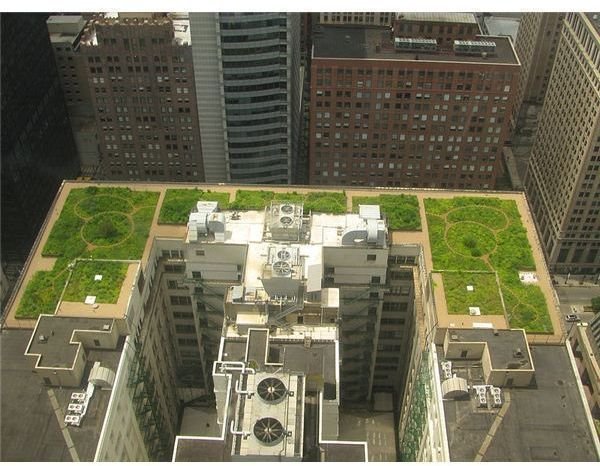Green Roofing - Innovative Green Roofing Systems
How Green Roofing Works
Almost everyone knows that summer in the city is hotter than summer in the country. This is because of the phenomenon known as the “urban heat island effect”: urban areas are significantly warmer than non-urban areas, due to the lack of shade trees and rapid evaporation of water. In a wooded, green area, the trees and vegetation absorb sunlight and provide shade, but in urban areas, all that metal and glass reflects the sunlight, and water rapidly runs off the roofs’ hard surfaces, leading to the flooding of streets during hard rainstorms and the loss of much usable water. Additionally, all that asphalt, concrete, and metal leaves very little room for green vegetation that filters out CO2 and other pollutants from the air.
Green roofs help to change all that. Adding plant life to part or all of a roof creates natural sound and heat insulation, prevents water run-off, and improves air quality. Green rooftops also help roofs last longer by adding a layer of protection between the rooftop and the wear-and-tear of the sun, wind, and rain.
The green roof atop Chicago’s city hall
Innovative Green Roofing Systems
In 2003, two Duke University engineering seniors had an idea: build an energy-efficient, green “smart home” for students to both live in and use as a lab to experiment with green technology. After years of fundraising, including partnering with Home Depot and gaining support from the University, the Home Depot Smart Home opened near Duke’s campus in November 2007.
The epitome of green construction, Duke’s Smart Home gained a platinum rating from LEED (Leadership in Energy and Environmental Design). Amongst the Smart Home’s many green features is its innovative green roofing system. Located in the sunny, drought-ridden southeast, the building team specifically chose drought-resistant plants to put on its green roof. Southerners know how hot the south can get, but the green roof reduces the urban heat island effect. The green roof naturally keeps the Smart Home cooler and aids in the harvesting of rainwater which is reused later.
Meanwhile, on the other side of the continent from Duke’s home in North Carolina, Vancouver in British Columbia, Canada, is also experimenting with green roofing systems. The Vancouver Convention Center’s huge roof – 2.5 hectare’s worth – is currently the largest green roof in North America. Planted with over 350,000 plants native to the area, the builders hope that heat gains will be reduced by as much as 95% during summer months, and will reduce heat losses by 26% in winter months (“Green Roof Growing Atop Convention Centre”). Considering the size of a convention center, this will translate into major savings in heating and cooling.
The Future of Green Roofing
Green roofing systems are not a new technology – popular in Europe for centuries and revitalized by Germany in the 1970s, green roofs have a long history. But with concerns over the long-term sustainability of the environment, the green construction movement, and programs like LEED, green roofing might finally become a common feature in cities in the US. In Chicago, city hall already sports a 20,000 square-foot green roof, which has saved the city $25,000 in heating and cooling costs during its first six years. And in Los Angeles, which costs $100 million per year to cool, former Mayor Richard Daley helped turn 2.5 million square feet of roofs green (Colwell).
The future of green roofing seems bright. While green roofing systems haven’t caught on entirely yet (making a residential roof green, for example, is still very pricey), projects like those in Chicago, Los Angeles, and Vancouver, as well as an increasing number of university projects like the one at Duke University, demonstrate tangible financial incentives for change. And in a capitalistic society, where there are tangible financial incentives, change will inevitably come.
Sources:
Colwell, Dara. “Green Roofs: Building for the Future.” AlterNet, 3/6/07.
Duke University Smart Home Program
“Green Roof Growing Atop Convention Centre.” British Columbia News, 7/11/08.
